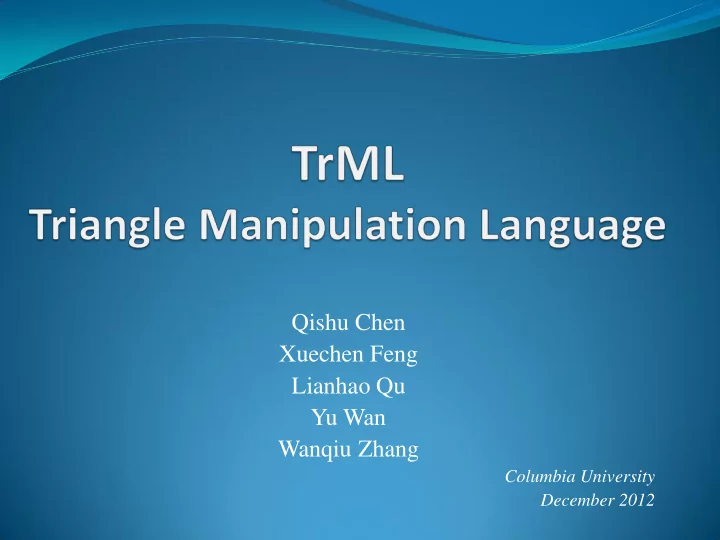

Qishu Chen Xuechen Feng Lianhao Qu Yu Wan Wanqiu Zhang Columbia University December 2012
Introduction-TrML A simple programming language that allows user to express trigonometry concept, and construct/solve complex trigonometry problems. C-like structure Functional language Allow programmers to easily express trigonometry concepts and solve trigonometry problems. Columbia University TrML Team Chen, Feng, Qu, Wan, Zhang
TrML Tutorial There are two data types in TrML: value and triangle. Value is a floating point number, and triangle is a triangle in 2D plane. @This is a comment @assign 4.0 to value i value i 4.0; @assign three vertex values to triangle ABC triangle ABC V [(1.1, 2.2),(3.3, 4.4),(5.5, 6.6)]; @assign three side-length values to triangle DEF triangle DEF L [4.2, 3.5, 3.6]; Columbia University TrML Team Chen, Feng, Qu, Wan, Zhang
TrML Tutorial @Sample code: “Hello World!” initialize: rule: operation: prints("Hello \nWorld!\n"); Columbia University TrML Team Chen, Feng, Qu, Wan, Zhang
TrML Tutorial initialize: value i 4.0; value sum 0.0; rule: operation: while(i > 0){ sum = sum + i; i = i - 1; } prints("The sum of "); printv(i); prints(" is:") printv(sum); @the result should be: The sum of 4.0 is 10.0 Columbia University TrML Team Chen, Feng, Qu, Wan, Zhang
Block Diagram Columbia University TrML Team Chen, Feng, Qu, Wan, Zhang
AST
Compiler Internal structure: Rule table Environment table Operation variable One stack register Code structure: Environment variable followed by “ rul ” followed by rules defination followed by “opt” followed by operations definition Columbia University TrML Team Chen, Feng, Qu, Wan, Zhang
Interpreter Java Based Two arguments lists Rule Argument, [rule counter] Operation Argument, [operation counter] Global variable list Register stack 30+ instruction sets Columbia University TrML Team Chen, Feng, Qu, Wan, Zhang
Summary Main goals: Acquire language and compiler design experience Have a coherent design and implement it correctly and in-time Outcome: TrML is a comprehensive and simple language Implementation was finished before the deadline and the compiler follows the design specification Columbia University TrML Team Chen, Feng, Qu, Wan, Zhang
Summary Suggestions for the future: Getting a head start: All group members were on the same page with starting early, but actually coordinating and forming the right pace for the team could still be improved. Pick a topic with passion: Pick a topic that most members are passionate about will make the experience worthwhile and enjoyable. Columbia University TrML Team Chen, Feng, Qu, Wan, Zhang
Testing code @ keyw||d "initialize:" starts triangle initialization phase initialize: @ initialize triangle with 2-D vertex location triangle ABC V [(1.1, 2.2) , (3.3, 4.4) , (5.5, 6.6)]; @initialize triangle with line segment length triangle DEF L [4.2, 3.5, 3.6]; value agl 10.0; value opq 5.0; @ Keyw||d "rules:" starts rules construction phase rules: identical_triangle (triangle Tri_1, triangle Tri_2) ( [[triangle Tri_1.sideA == triangle Tri_2.sideA ] && [triangle Tri_1. sideB == triangle Tri_2. sideB] && [triangle Tri_1. sideC == triangle Tri_2. sideC]] || [[triangle Tri_1.sideA == triangle Tri_2.sideB] && [triangle Tri_1. sideB ==triangle Tri_2. sideC] && [triangle Tri_1. sideC == triangle Tri_2. sideA]] || [[triangle Tri_1. sideA == triangle Tri_2. sideC] && [triangle Tri_1. sideB ==triangle Tri_2. sideA] &&[triangle Tri_1. sideC == triangle Tri_2. sideB]] ) {true}; @ Explain angleC in terms of sides @ This is a calculation rule angle_C (triangle ABC) (true) {arccos((triangle ABC.sideA * triangle ABC.sideA) + (triangle ABC.sideB * triangle ABC.sideB) - (triangle ABC.sideC * triangle ABC.sideC) / 2.0 * triangle ABC.sideA *triangle ABC.sideB)}; @ keyw||d "operations:" starts operation && calculation phase operations: agl = rule identical_triangle (triangle ABC, triangle ABC); opq = 5.0; printv (value agl); if (value agl) { prints ("ABC and DEF are identical"); } if (1.0) { prints ("is regular triangle"); }
Columbia University TrML Team Chen, Feng, Qu, Wan, Zhang
Recommend
More recommend